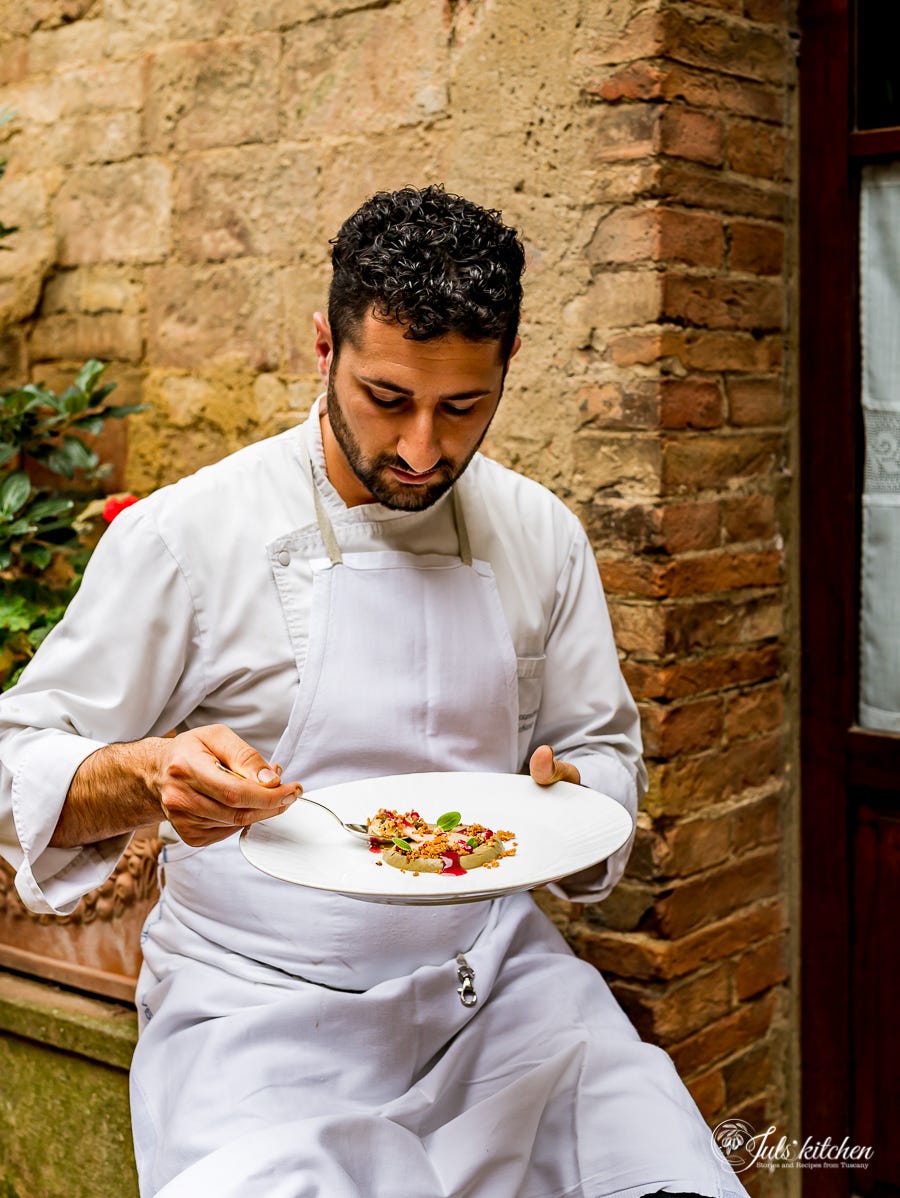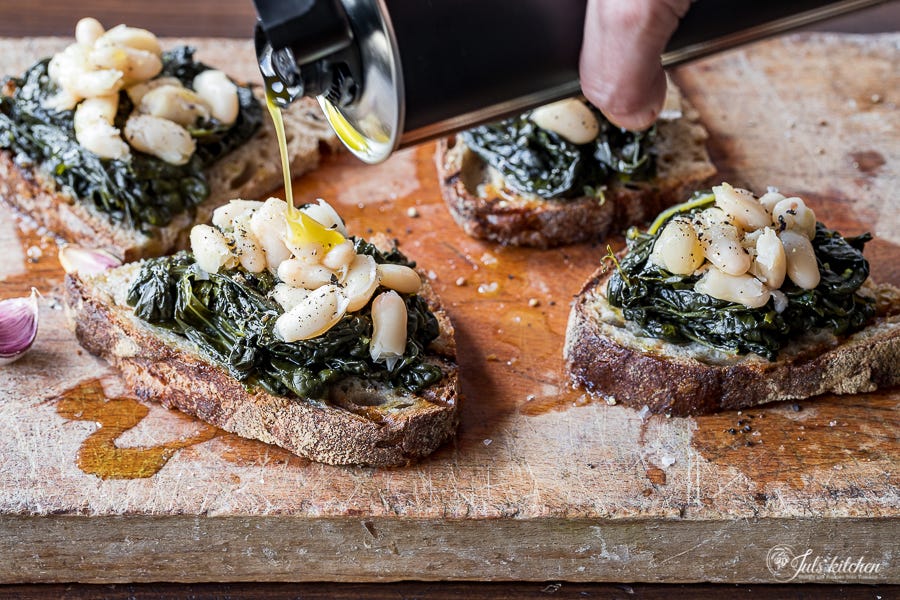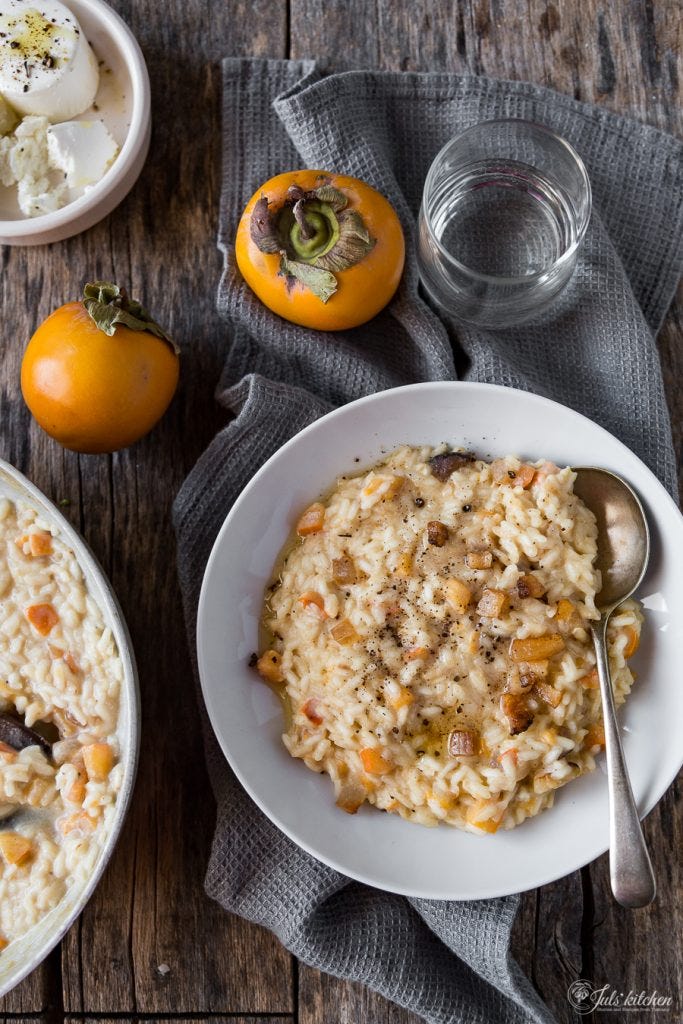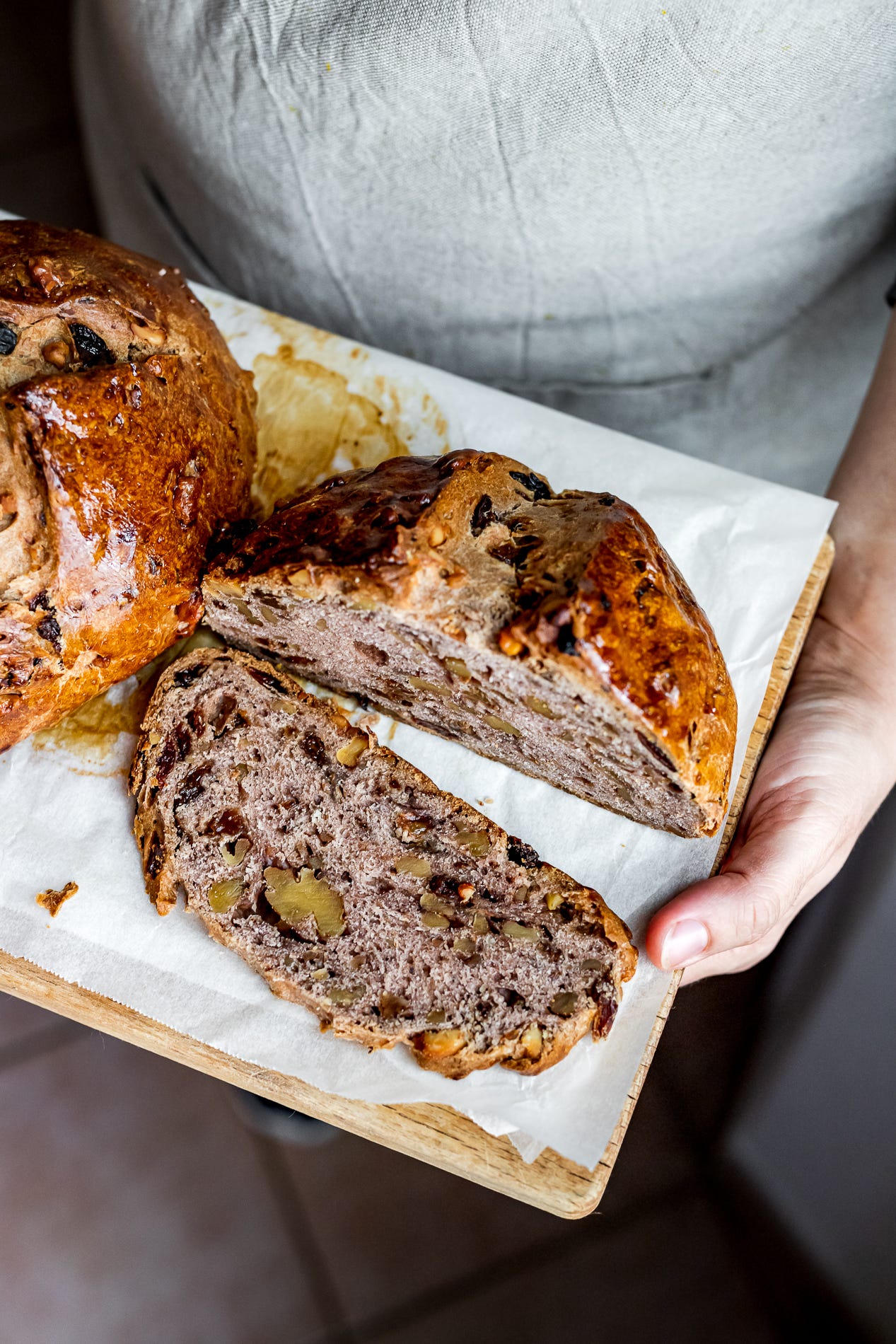Welcome, November. Braised cabbage with sausages + links
A letter with 10 recipes to cook this month, and an insight on what I'm reading and cooking right now.
Goodbye, October.
You have been busy, but gentle with me.
I prepared for Favuzzi panforte olive oil chocolate truffles, you can watch the live show here.
I spent time with my friends Sarka and Tiina who came to visit us in Tuscany.
I cooked a recipe from Ottolenghi’s latest book with Myriam, Sara, and Artemisia. You can watch the IG live here. Spoiler: the recipe was outstanding.
We shared our Autumn Recipe Guide. You can read about it here, where you will find all the (easy) steps to get it.
In the subscription-based newsletter, we shared recipes for Focaccine with taleggio and mushrooms, Crostata di frutta fresca, Caprese cake, and Chestnut flour tagliatelle with porcini and sausages.
We celebrated a few family birthdays: my sister Claudia, her boyfriend Marco, and Tommaso’s.
I returned to the swimming pool after 18 months, a pandemic, several lockdowns, a pregnancy, and a baby. It felt soooo good.
Welcome, November.
Welcome, November, with your foggy mornings, the smell of toasted pan co' santi at breakfast, the first nights spent in front of a burning fire, the roasted chestnuts, the jammy persimmons, and the olio nuovo. When I was younger, I wished I could skip you to get to December and the Christmas lights. I have no hurry now.
Now I truly enjoy your intimate atmosphere, the fall and winter vegetables that cram the market stalls, a cosy moment spent in front of our wood-burning stove reading a new cookbook, a walk in the mid-afternoon with Livia, surrounded by a landscape dressed in fiery colours.
November, you look good to me, I finally learnt to appreciate you. I just hope I'll be able to slow down to cherish the little things that make you precious, like lighting a candle when I wake up early to work on our cookbook manuscript, or brewing a tea in the afternoon before Livia comes back home from the nursery school. You are unseasonably warm, so I wish I'll wake up soon to a snap of cold that will make me reach for my big red woollen cardigan, a safe hug throughout the day.
What I am cooking
I baked my pan co' santi, and with this dense, spiced Tuscan bread, studded with raisins and walnuts, enriched with red wine, extra virgin olive oil, and sugar, I ushered in the Tuscan festive season. I boiled a big pot of beans and some Tuscan kale to taste the new olive oil, the olio nuovo, along with a toasted slice of bread, that we call fettunta, namely a greasy slice of bread. It is a Tuscan tradition to welcome the olio nuovo, and obviously, I made it mine.
I bought my first Savoy cabbage of the season, then a second, and a third. I cooked again this potato and Savoy cabbage soup, a recipe that dates back to 2013, then I braised the cabbage with sausages, a seasonal Tuscan recipe from Livorno, adapted from our cookbook From the Markets of Tuscany, that you can find on the blog today.
What I am reading
November means always The Christmas Chronicles, by Nigel Slater.
I first virtually met Nigel Slater online, thanks to the seasonal, vibrant recipes he shares on The Guardian weekly. I started following him on Social Media, and this is when I discovered he had a new book coming out soon, The Christmas Chronicles. It was Autumn 2017. This marks the beginning of my unconditioned love for Nigel Slater, his humour, his Britishness.
After The Christmas Chronicles, I started collecting and reading all his books: first his memoir, Toast, then Tender, The Kitchen Diaries, up to Greenfeast Spring, Summer and Greenfeast Autumn, Winter. I just received his latest A Cook's Book, and from the few pages I've read it is another great book.
But back to The Christmas Chronicles, a collection of notes, stories and recipes for midwinter, that I'm re-reading every year since 2017.
This is probably what I like the most about this book, the fact that it is not just focused on Christmas: it is Nigel’s diary, with glimpses of life, memories and recipes, from the 1st of November to the 2nd of February, it embraces the whole magical season of winter: there are stories about decorations, gardening, trips to Japan and Vienna, about choosing the perfect fir to decorate, he talks about panettone and panforte, about making a wreath for your door, or wrapping up Christmas presents.
I came late to discover a love for winter. Growing up, it was summer the season when I felt free, invincible. Now I, a July girl, thrive in winter, in the season of fireplaces, hearty stews, frozen mornings, Christmas lights, candles, woollen scarves.
I love every single page of this book, every recipe I have cooked, each description, emotion, memory. It is a book to treasure.
I made Nigel’s dried fruit drinks for winter: apricot, orange and anise with brandy, figs and maple syrup with vodka and muscat prunes and sultanas. I tried his Christmas cake, which is now sitting in my pantry, fed every week with a drizzle of whiskey. We loved his roasted pumpkin with dukkah and pomegranate.
Where I have been
In October we visited some of Volterra’s best restaurants and food shops thanks to Confcommercio Pisa for Vetrina Toscana, a project by Tuscany Region and Unioncamere that promotes restaurants and food stores that use local products, as well as authentic producers. Spotting the Vetrina Toscana logo on a restaurant door is a guarantee of quality for tourists and locals alike. Volterra is a town that does not give up. Dealing with its geographical isolation, it has always preserved its traditions and its authentic spirit. Unlike many postcard-like towns that sold their souls to the hit and run tourism, forgetting their inhabitants, Volterra has been able to combine these two aspects.
On the one hand, with its museums, the Etruscan gates, the amphitheatre, the alabaster and the pecorino and the unique landscape that surrounds it, Volterra attracts tourists from all over the world. On the other, though, it offers its residents everything they need, to make them feel at home, and not guests of an amusement park.
You can find all the restaurants we visited here.
A new recipe on the blog - Cavolo strascicato - Braised cabbage with sausages
If you try it, share the results with us on social media by using the hashtag #myseasonaltable and tagging @julskitchen on Instagram.
"Use one sausage per person,” says Antonio. “This isn’t a side dish after all, but a main course to eat with plenty of bread for cleaning your plate.”
This is how Antonio, known at the Piazza Cavallotti market as the “king of lettuce,” explained the following recipe to me, with its fragrant garlic in a bit of olive oil, and chilli pepper, too, that ingredient we now know to be vital and abundant in the Livornese cuisine.
You can find the recipe for braised cabbage with sausages on the blog.
If you have questions about the ingredients or the recipe, if you have a special request for one of the next cooking projects, or if you just want to have a chat, just reply to this email.
Ten recipes to cook this month
Broccoli and squash flans. Made with seasonal vegetables, ricotta, and a genuine cheese like Piave DOP vecchio, the broccoli and squash flans also make for a balanced main course during weekdays. You can prepare them in advance and reheat them just before dinner. Serve them with baked fennels, or even a simple green salad dressed with olive oil and lemon juice citronette.
Crostoni with Tuscan kale. Cook the cavolo nero for longer than you would expect, to soften its fibrous leathery leaves, until it surrenders in a buttery mess. Don’t drain it completely, as its flavourful cooking water will soften the toasted bread rubbed with garlic. Top each slice of bread cavolo nero and a generous spoonful of cooked cannellini beans, then season with salt and chilli pepper, and drizzle with olio nuovo.
Cauliflower and cannellini soup. This soup is thick, warming, consoling, a good way to use your leftover beans, and, mostly, a meal on its own. A velvety hot soup served in a bowl that seems to be made exactly to be hugged, it is everything I need at the end of a cold working day.
Savoy cabbage soup. This easy peasy soup has two little extras. First, your best extra virgin olive oil, second, a few toasted black peppercorns. Toast the pepper and finely chop it with your knife: this will infuse an exotic taste to your soup.
Persimmon risotto with pancetta and goat cheese. The persimmon makes the risotto slightly sweet, but the other ingredients perfectly balance the final taste of the risotto. The browned pancetta adds a savoury richness while the melting goat cheese contributes with a slightly acid and creamy touch. This risotto is like a hug, a seasonal and festive dish.
Chestnut flour pasta with walnut sauce. Here in the Lunigiana, pasta is sometimes known as bastarda, meaning “illegitimate”, as the wheat flour is cut with some chestnut flour. The lasagna made in this area is comprised of irregularly shaped pieces of eggless pasta, with only a small amount of water and lots of elbow grease. Usually, the percentage is 3 parts to 1, where chestnut flour is used in a smaller amount as it is a gluten-free flour, so it is almost impossible to make fresh pasta just with chestnut flour.
Grilled sausages and Sauerkraut. Today we won’t follow the fermentation route, but we’ll opt instead for a cooking process that gives the cabbage a delicate sweet and sour taste. The result is a sweet and sour side dish, which naturally marries pork: not only sausages but also steaks, scamerita – the typical Tuscan cut from the neck of the pork, fat and flavourful –, sirloin medallions or roast loin.
Chicken cacciatore. What makes a dish “alla cacciatora”? The meat of choice is that of a farmyard animal – not only chicken but often also rabbit or guinea fowl -, braised in a pan on the stovetop. It has a robust flavour, given especially by the thick sauce cloaking the meat. This rustic sauce calls for polenta, a crusty country loaf, or even a bowl of homemade egg noodles.
Pan co’ santi. Pan co’ Santi is a dense, spiced Tuscan bread, studded with raisins and walnuts, enriched with red wine, extra virgin olive oil, and sugar. What looks like a rather heavy and dense bread loaf is indeed what ushers in the Tuscan festive season.
Castagnaccio, the Tuscan chestnut cake. Castagnaccio is an ancient recipe, a dessert that speaks to the Tuscan peasant woman’s triumph over poverty and hunger. The simplest version involves a basic mix of chestnut flour, water, oil and rosemary, resulting in a cake with an almost biting, smoky flavour and a texture similar to bread pudding. And yet castagnaccio is in some ways a surprisingly modern dessert. It contains no sugar and is naturally gluten and lactose-free.
What are you planning to cook this month? Is there something you are excited to reintroduce to your cooking routine? Let me know in the comments, I’m always happy to add new recipes to my cooking repertoire.
Are you in the Southern Hemisphere?
Let me tempt you with potato gnocchi with asparagus and spring onions, green bean and potato salad, and chocolate panna cotta with strawberries.
Are you interested in more original recipes?
So you should consider subscribing to our weekly newsletter.
What you missed recently: Focaccine with taleggio and mushrooms, Crostata di frutta fresca, Caprese cake, Chestnut flour tagliatelle with porcini and sausages.
If you join us, you will receive a new exclusive recipe inspired by ingredients, season, or tradition every week. You will discover Italian classics, weeknight ideas with an Italian flair, reliable dishes to add to your cooking repertoire.
Subscribing to the newsletter, you will support us directly. Whenever you decide to join us, you will have complete access to the whole archive of already published recipes and stories.
We love Letters From Tuscany as it is like having our own independent publication: we test, photograph, write each recipe just for you. It is a way of sharing great content, recipes that we like, created to inspire you, to bring a little taste of Italy to your kitchen, for you and your family.
Join our virtual cooking classes
We’ve been working on new courses and videos. Read more about the courses here on the blog to stay updated.
Virtual cooking courses currently available:
Each course includes:
step-by-step cooking demonstrations,
a PDF with ingredients, tools, and instructions of each recipe,
lifetime access,
free access to upcoming new recipes.









